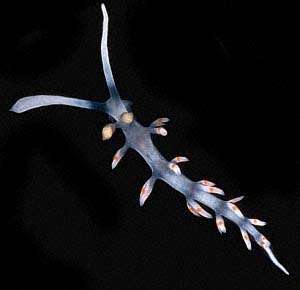
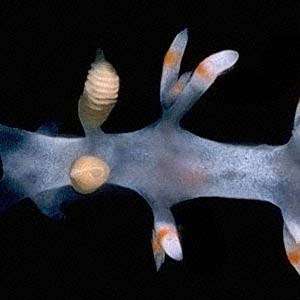
Flabellina bicolor
(Kelaart, 1858)
Order: NUDIBRANCHIA
Suborder: AEOLIDINA
Family: Flabellinidae
DISTRIBUTION
Widespread in the tropical Indo-West Pacific.
PHOTO
Noumea, New Caledonia, October 1988. Lower photo showing dorid-like lamellate rhinophore clubs characteristic of this species. PHOTOS: Bill Rudman.
Flabellina bicolor is characterised by its white body and the subterminal golden band on each cerata. It is one of a group of species with lamellate rhinophores, and with oral tentacles with a flattened terminal lobe. When this aeolid is crawling along the flattened paddle-like oral tentacles are continually flapping up and down apparently testing the substrate the animal is crawling over.
Reference:
• Gosliner,T.M. & Willan,R.C. (1991) Review of the Flabellinidae (Nudibranchia: Aeolidacea) from the tropical Indo-Pacific, with the descriptions of five new species. The Veliger, 34(2): 97-133.
Rudman, W.B., 1999 (February 23) Flabellina bicolor (Kelaart, 1858). [In] Sea Slug Forum. Australian Museum, Sydney. Available from http://www.seaslugforum.net/find/flabbico
Related messages
Flabellina bicolor from Okha, Gulf of Kutch,India
January 19, 2010
From: Bhavik Patel
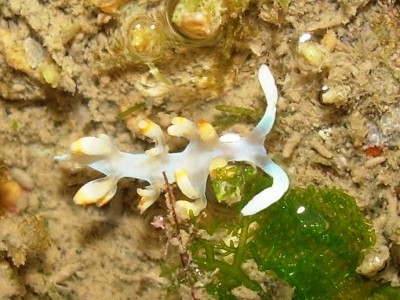
Dear Bill,
I am working in Bombay Natural History Society as Education Officer. Recently I was in the Okha reef, Gulf of Kutch,Gujarat, India on a survey trip. During the visit I found this slug which was later on identified as Flabellina bicolor by my colleague Dishant Parasharya. This observed specimen, about 0.3 cm in length, was roaming around alone on the small flat surfaced rock covered with small algae patch. It was feeding on the algae (sp. not been identified) and was about at 10 cm. depth. Photograph was taken with Nikon Coolpix L4.
Locality: Okha jetty, 10 cm., Gujarat,India, Gulf of Kutch, 13 January, 2010, Rocky Habitat with spotted tidal pool and algae patches. Length: 0.3 cm. Photographer: Bhavik Patel.
Bhavik Patel
pbhavik79@gmail.com
Patel, B.K., 2010 (Jan 19) Flabellina bicolor from Okha, Gulf of Kutch,India. [Message in] Sea Slug Forum. Australian Museum, Sydney. Available from http://www.seaslugforum.net/find/23107
Dear Bhavik,
I remember finding this species at Okha in 1971, but I was so short of film I could only take one photo which was terribly overexposed. Although your animal is very small we can see the flattened 'paddle-like' oral tentacles. As I have mentioned elsewhere this is one of a few species of Flabellina with these paddle-shaped tentacles which are flapped up and down as the animal crawls along. Although it seems rather interested in the green algae, aeolid nudibranchs are carnivorous, and all flabellinids, with the possible exception of Flabellina trophina, feed on hydroids.
Best wishes,
Bill Rudman
Flabellina bicolor (?) from Korea
February 25, 2008
From: Dong Bum Koh
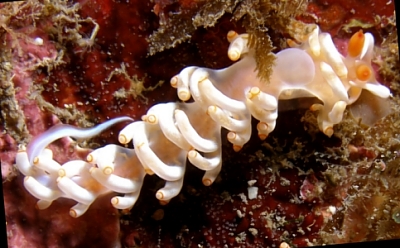
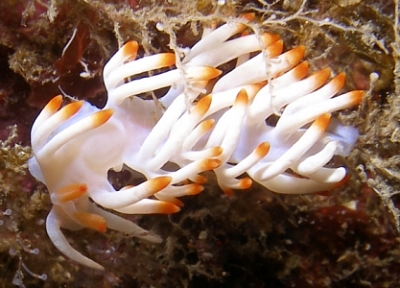
Dear Bill,
Concerning my previous messages #8478, #8332, here are some photos of Flabellina bicolor(?) was taken in Jeju island. There are more popular species in Jeju fauna and two guys are just little different in shape especially in ceratas.
I regard as a different species but I'm not sure.
Could you give some comments for me?
Locality: Moon islet, 15m, Seogwipo City, Pacific, Nov.2007. Length: 20~40 mm. Photographer: Joo Hong Gang.
Best regards,
Dong Bum Koh
drkoh@seasee.co.kr
Koh, D.B., 2008 (Feb 25) Flabellina bicolor (?) from Korea. [Message in] Sea Slug Forum. Australian Museum, Sydney. Available from http://www.seaslugforum.net/find/21223
Dear Koh,
As I said in earlier comments about this Korean species [#8478, #8332], it is possible it is not F. bicolor but we would need to check its anatomy. Its an interesting 'species' or colour form. Sometimes the ceratal tips have a thin subapical orange band while in others there is a very wide diffuse ornage zone subapically. Also the oral tentacles look rather different from the paddle-shaped tetacles of 'typical' F. bicolor.
Best wishes,
Bill Rudman
Flabellina bicolor from South Africa
September 18, 2007
From: Valda Fraser

Dear Bill
Hope you can help with identification. Thanks
Locality: Pumula, KwaZulu-Natal, 35 m, South Africa, Indian, March 2007, Reef. Length: 15 mm. Photographer: Valda Fraser.
Regards
Valda Fraser
valdafraser@mweb.co.za
Fraser, V.J., 2007 (Sep 18) Flabellina bicolor from South Africa. [Message in] Sea Slug Forum. Australian Museum, Sydney. Available from http://www.seaslugforum.net/find/20686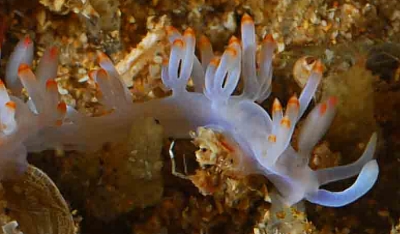
Dear Valda,
This is a pair of Flabellina bicolor. The way the cerata are arranged in groups with a common stalk, and the paddle-shaped oral tentacles are characteristic of this species.
Best wishes,
Bill Rudman
Flabellina bilas maybe? from the Red Sea
August 11, 2007
From: Oren Lederman
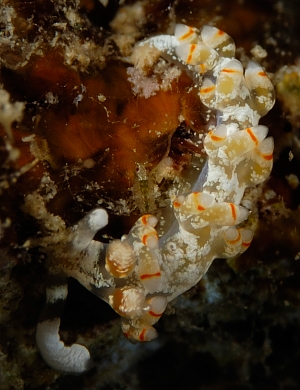
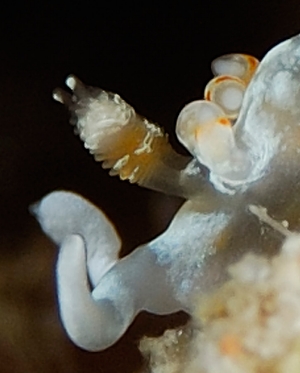
Hi Bill,
Attached are 3 photos showing two different specimens of a species I couldn't identify. Binyamin Koretz suggested it's a Flabellina bilas.
, ~6 meters, Israel, Red Sea, 11 May 2007. Length: ~5 mm. Photographer: Oren Lederman.
Can you help identify it?
Oren
oren.lederman.public@gmail.com
Lederman, O., 2007 (Aug 11) Flabellina bilas maybe? from the Red Sea. [Message in] Sea Slug Forum. Australian Museum, Sydney. Available from http://www.seaslugforum.net/find/20156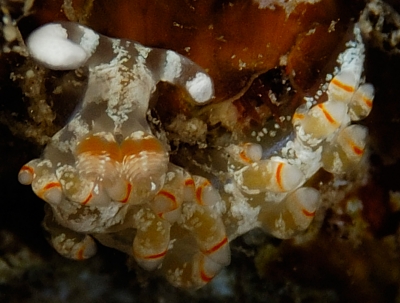
Dear Oren,
I am beginning to wonder now whether Insian ocean animals [messages #10243, #6224] are in fact correctly identified as C. bilas. Overall they look quite like the Pacific F. bilas but the banding on the cerata is not quite the same. Your animals here may be a lighter version of the same thing or perhaps a speckled version of F. bicolor. I see I have identified an earlier find of this animal by Binyamin as F. bicolor [#15504]. I'm afraid there is only so far we can go with photos - this is a case where the animals will need to be looked at internally. For the moment I will tentatively identify it as F. bicolor.
Best wishes,
Bill Rudman
Flabellina bicolor feeding
January 26, 2007
From: Leanne & David Atkinson
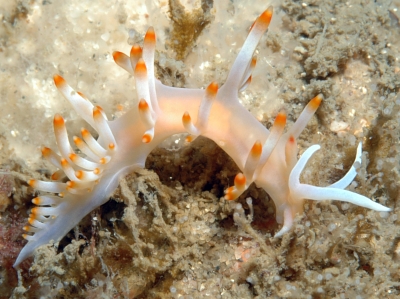
Hi Bill,
We found this Flabellina bicolor and it looks as if it is feeding on hydroids like the one in Nicholas Missendon's message #18485. We managed to get some close up shots of the head. Can you tell if it is feeding?
Locality: The Pipeline, Port Stephens, 12 metres, New South Wales, Australia, Pacific, 26 August 2006, Silty sand bottom with scattered sponges, ascidians, soft corals, hydroids and bryozoans. Length: approximately 30mm. Photographer: Leanne & David Atkinson.
Regards,
Leanne & David Atkinson
atk@hunterlink.net.au


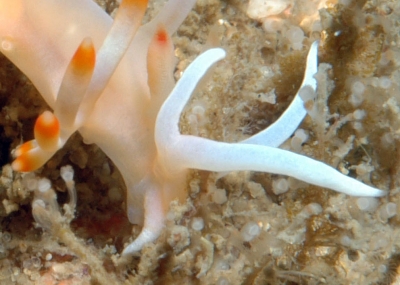
Dear Leanne & David,
The little white stalked 'blobs' in your photos are definitely hydroids, so I feel pretty confident in saying that I suspect this animal is feeding. Often when aeolids are feeding like this you will see the head jerk back every now and then, which is when it pulls off the polyp. These animals have large jaw plates on either side of the mouth which they use to 'bite' off the individual polyps or part of the polyps. The edge of the jaws is often not strong enough to bite through the prey, so they use the jaw plates to hold the prey tight and rip it off with a quick backwards jerk of the head.
One thing I can see on the head is a rather obvious extra pair of oral tentacles - another one for the abnormalities page.
Best wishes,
Bill Rudman
Flabellina bicolor from Bare Island, Sydney
November 23, 2006
From: Nicholas Missenden
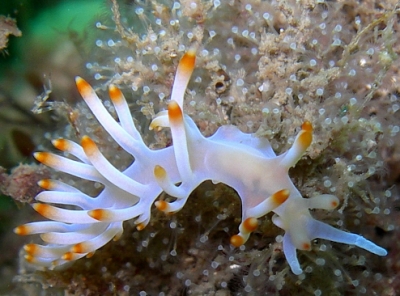
Hello again Bill,
Hope you had a great holiday.. Anyway, I was diving yesterday on the South of Bare Island, Laperouse and came across this nudibranch.
Locality: Bare Island, South Wall, 15 m, NSW, Australia, Botany Bay, 20 November 2006, Broken reef, sandy bottom. Length: 2 cm. Photographer: Nicholas Missenden.
I thought that it was some form of Flabellina but I can't seem to find it in any of my reference books or on your forum. Could you help me identify it please?
Regards
Nick
njmpm@iinet.net.au
Missenden, N.J., 2006 (Nov 23) Flabellina bicolor from Bare Island, Sydney. [Message in] Sea Slug Forum. Australian Museum, Sydney. Available from http://www.seaslugforum.net/find/18485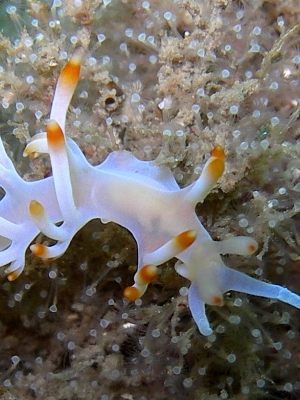
Dear Nick,
It is indeed a Flabellina - Flabellina bicolor. This is a rare tropical visitor to Sydney. It is apparently feasting on the colony of small hydroids it is crawling on - each of the white blobs is a small hydroid polyp.
Best wishes,
Bill Rudman
Flabellina bicolor from Bali
February 16, 2006
From: Marli Wakeling

Hi Bill,
I think this is Flabellina bicolor. The image is soft, as the nudi was very small.
Locality: Tulamben, Bali, Indonesia. Depth: 20 feet. Length: 8 mm. 24 July 2005. sand and rubble slope. Photographer: Marli Wakeling
Cheers,
Marli
scubamarli@gmail.com
Wakeling, M., 2006 (Feb 16) Flabellina bicolor from Bali. [Message in] Sea Slug Forum. Australian Museum, Sydney. Available from http://www.seaslugforum.net/find/15190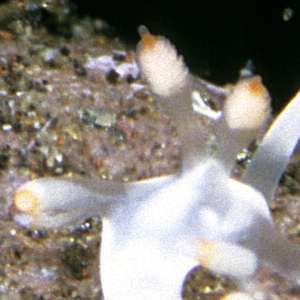
Dear Marli,
Your photo shows the rhinophores well.
Best wishes,
Bill Rudman
Flabellina bicolor from Lembeh St, Indonesia
January 12, 2006
From: Ken Tucker
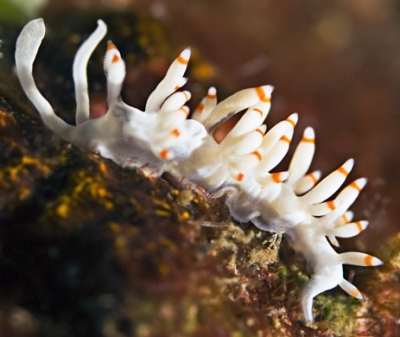
Dear Bill,
I have not been able to match to either SS database or any other reference material. I have numerous photos. Can you suggest?
I suspect it is some sort of worm instead.
Locality: Reef. Indonesia, Lembeh Strait. Depth: perhaps 30-40 ft. 5 Nov 2005. Photographer: Ken Tucker
Ken Tucker
ken@kilili.com
Tucker, K.C, 2006 (Jan 12) Flabellina bicolor from Lembeh St, Indonesia. [Message in] Sea Slug Forum. Australian Museum, Sydney. Available from http://www.seaslugforum.net/find/15521Dear Ken,
Although it does look a bit like a polychaete worm, this is the aeolid Flabellina bicolor. Your photo shows how the two oral tentacles, at the front of the body, flatten out to form two paddle-shaped structures which wave up and down as the animal is crawling along.
Best wishes,
Bill Rudman
Flabellina bicolor from the Red Sea
January 11, 2006
From: Binyamin Koretz
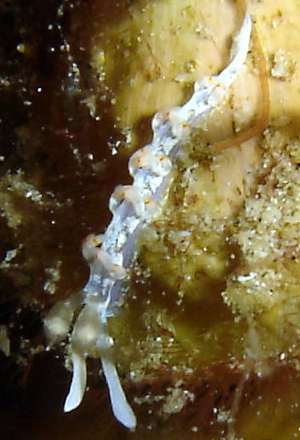
Dear Bill,
Assuming that this is Flabellina bicolor, it's previously reported from the Red Sea but I noticed that all the messages on the Forum were from the Pacific.
Locality: Eilat, Princess Beach, Israel. Red Sea (Gulf of Eilat). Depth: 25 m.
Length: 1.5 cm. 22 December 2005. corals. Photographer: Binyamin and Shulamit Koretz
Best regards
Binyamin
binyamin@koretz.net
Koretz, B., 2006 (Jan 11) Flabellina bicolor from the Red Sea. [Message in] Sea Slug Forum. Australian Museum, Sydney. Available from http://www.seaslugforum.net/find/15504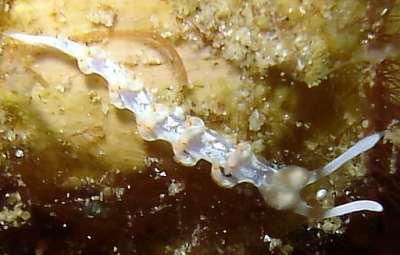
Thanks Binyamin,
It's nice to have an Indian Ocean example on the Forum. Your photo shows the flattened 'paddle-shaped' oral tentacles rather well.
Best wishes,
Bill Rudman
Flabellina bicolor from Japan
December 20, 2003
From: Jason Bell
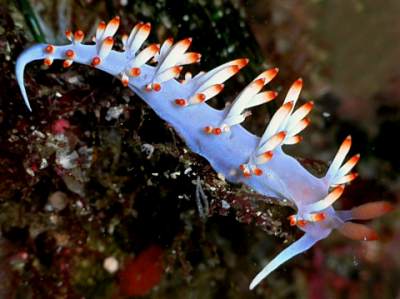
Bill,
I observed this Flabellina bicolor on Hatsushima Island, Japan 16 November 2003. It was located on the other side of the boulder that Sagaminopteron ornatum was found. It was at about 15m and the water temp. was around 20-21 degrees C.
Jason
belljason@hotmail.com
Bell, J., 2003 (Dec 20) Flabellina bicolor from Japan. [Message in] Sea Slug Forum. Australian Museum, Sydney. Available from http://www.seaslugforum.net/find/11474Thanks Jason,
Bill Rudman
Flabellina bicolor from Sth Korea
December 21, 2002
From: Dong Bum, Koh
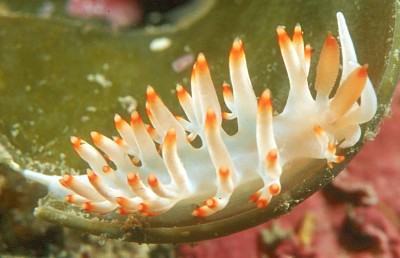
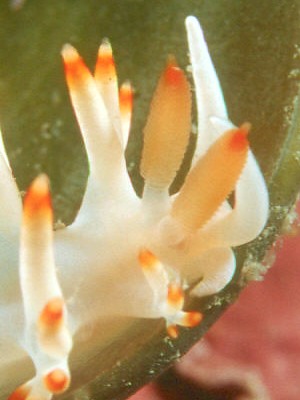
Dear Bill,
Following my recent message, here is another good shot of Flabellina bicolor. I hope it'll be helpful for your ID.
Best wishes,
Dong Bum, Koh
drkoh@seasee.co.kr
Koh, D.B., 2002 (Dec 21) Flabellina bicolor from Sth Korea. [Message in] Sea Slug Forum. Australian Museum, Sydney. Available from http://www.seaslugforum.net/find/8478Dear Dong Bum,
Thanks for these photos. I woudn't be surprised if there was more than one species with very similar colour patterns
Best wishes,
Bill Rudman
Flabellina bicolor? from sthn Korea
November 21, 2002
From: Dong Bum, Koh
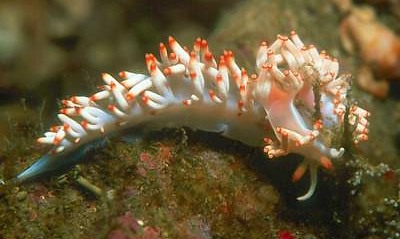
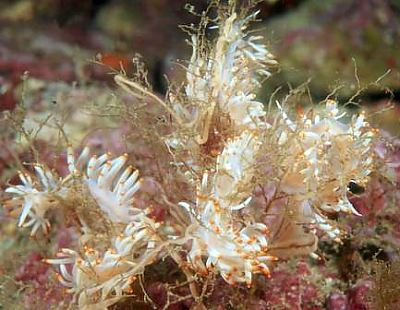
Dear Bill,
These photos were taken at Moon Islet, CheJu Is, South Korea. I suspect that this is Flabellina bicolor. Can you tell me if this is true and more information.
Upper photo: 27. Oct. 2002 Depth 13m
Lower photo: Sep. 1998. Depth 10m at night - showing a group and massive egg bands
Best regards,
Dong Bum, Koh
drkoh@seasee.co.kr
Koh, D.B., 2002 (Nov 21) Flabellina bicolor? from sthn Korea. [Message in] Sea Slug Forum. Australian Museum, Sydney. Available from http://www.seaslugforum.net/find/8332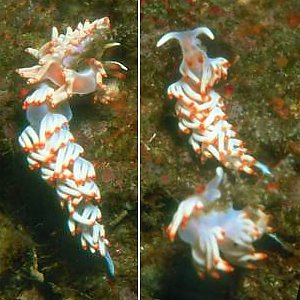
Dear Dong Bum,
I have included one of your 27 October 2002 photos here. I suspect that we may be mixing more than one species into what we are calling Flabellina bicolor. Your animals seems to have a distinct edge to the mantle, forming a white line down each side between the ceratal clumps. The oral tentacles seem to be a lot shorter and don't seem to form the white terminal 'paddles' seen in more typical examples of the species. Also there seem to be many more rows of cerata than usual. It would be helpful to know what the rhinophores look like more clearly. Are they lamellate? In many ways it reminds me of the Mediterranean Flabellina babai
Best wishes,
Bill Rudman
Flabellina bicolor from Hong Kong
January 26, 2002
From: Bernard Picton
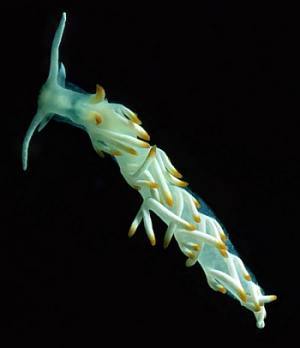
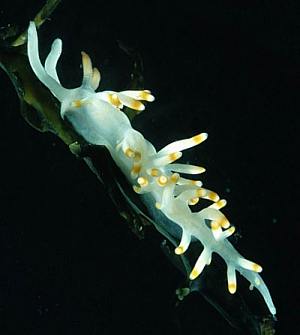
Hi Bill,
The pictures of this species on the Forum all seem to be of small animals, judging from the number of cerata. I've scanned pictures of two individuals from Hong Kong, April 1983. One shows the orange rings almost terminal on the cerata, the other more subterminal.
UPPER: - BEPHK13 - 7 Apr 1983 - E. Kong Chau, Mirs Bay
LOWER: - BEPHK96 - 11 Apr 1983 - NW Kong Chau, Mirs Bay
Bernard
bernard.picton.um@nics.gov.uk
Picton, B., 2002 (Jan 26) Flabellina bicolor from Hong Kong. [Message in] Sea Slug Forum. Australian Museum, Sydney. Available from http://www.seaslugforum.net/find/5951Thanks Bernard,
Bill Rudman
Flabellina bicolor
August 5, 2001
From: Erwin Köhler
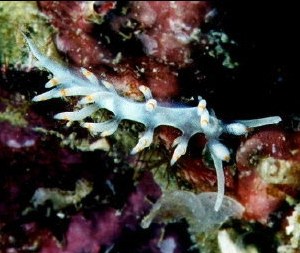
Dear Bill,
Here is the next one from Thailand, Phi Phi Islands, divesite "Maya Bay", depth 11m, size 13 mm, date Dec. 17, 2000. Is it Flabellina bicolor?
Erwin
Erwin@medslugs.de
Köhler, E., 2001 (Aug 5) Flabellina bicolor. [Message in] Sea Slug Forum. Australian Museum, Sydney. Available from http://www.seaslugforum.net/find/3837Dear Erwin,
Yes it's Flabellina bicolor.
Best wishes,
Bill Rudman.
Flabellina bicolor from Hong Kong
July 21, 2001
From: Leslie Chan

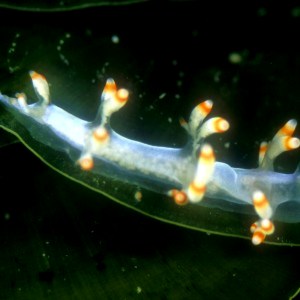
Dear Bill,
Could you identify this nudibranch which I photographed in Hong Kong.
Details: 12m, Tsim Chau, Hong Kong. 27 August 2000.
Thanks
Leslie Chan
leslie@lesmart.com
Chan, L., 2001 (Jul 21) Flabellina bicolor from Hong Kong. [Message in] Sea Slug Forum. Australian Museum, Sydney. Available from http://www.seaslugforum.net/find/4760Dear Leslie,
This is Flabellina bicolor. It looks like it has sustained some body damage, perhaps through a predator. It's left rhinophore is damaged, and the body seems to have been cut or bitten off at the level of the 4th ceratal group. Regrowth is probably quite quick, but we really don't have much information on the topic.
Bill Rudman
Tonga Records: Flabellina bicolor
May 29, 2001
From: Don Barclay

Malo Bill,
Here's a photo of Flabellina bicolor, also collected under a slab in about 10 meters of water on the afternoon of 16 February, 2001. It was under a slab in a rubble area across the channel from the Tongan Beach Resort, Utungake Island, Vava'u, Tonga . Size 15mm.
Cheers,
Don
n5ols@samoatelco.com
Barclay, D., 2001 (May 29) Tonga Records: Flabellina bicolor. [Message in] Sea Slug Forum. Australian Museum, Sydney. Available from http://www.seaslugforum.net/find/4407Thanks Don,
Bill Rudman
Flabellina bilas? from Philippines
February 16, 1999
From: Erwin Koehler


Dear Bill,
Here are two photos of Flabellina bilas (Gosliner & Willan, 1991), "snake island (dive site)", Pamilacan Is., Philippines, Nov. 1998.
Erwin Koehler
E.Koehler@deutschepost.de
Koehler, E., 1999 (Feb 16) Flabellina bilas? from Philippines. [Message in] Sea Slug Forum. Australian Museum, Sydney. Available from http://www.seaslugforum.net/find/568Dear Erwin,
I am pretty sure that your animal is Flabellina bicolor which has a single gold band or circle on the cerata. In Flabellina bilas there are three subterminal coloured bands - one red band bordered, on each side, by a creamy white band. Unfortunately I haven't a photo to put up for comparison. Both species have a lamellate or "perfoliate" rhinophores and both have large "active" oral tentacles which can develop a flattened paddle-like region near the tip (see photo at top of page).
Best wishes,
Bill Rudman.
